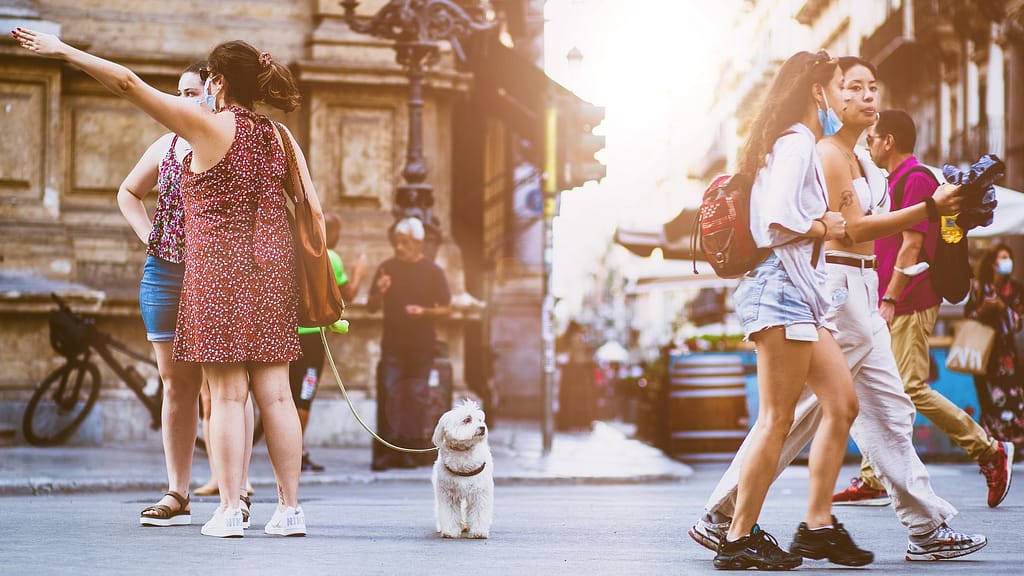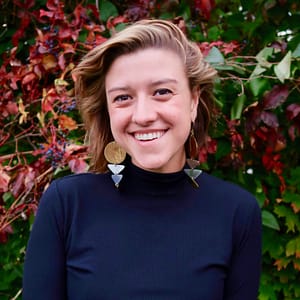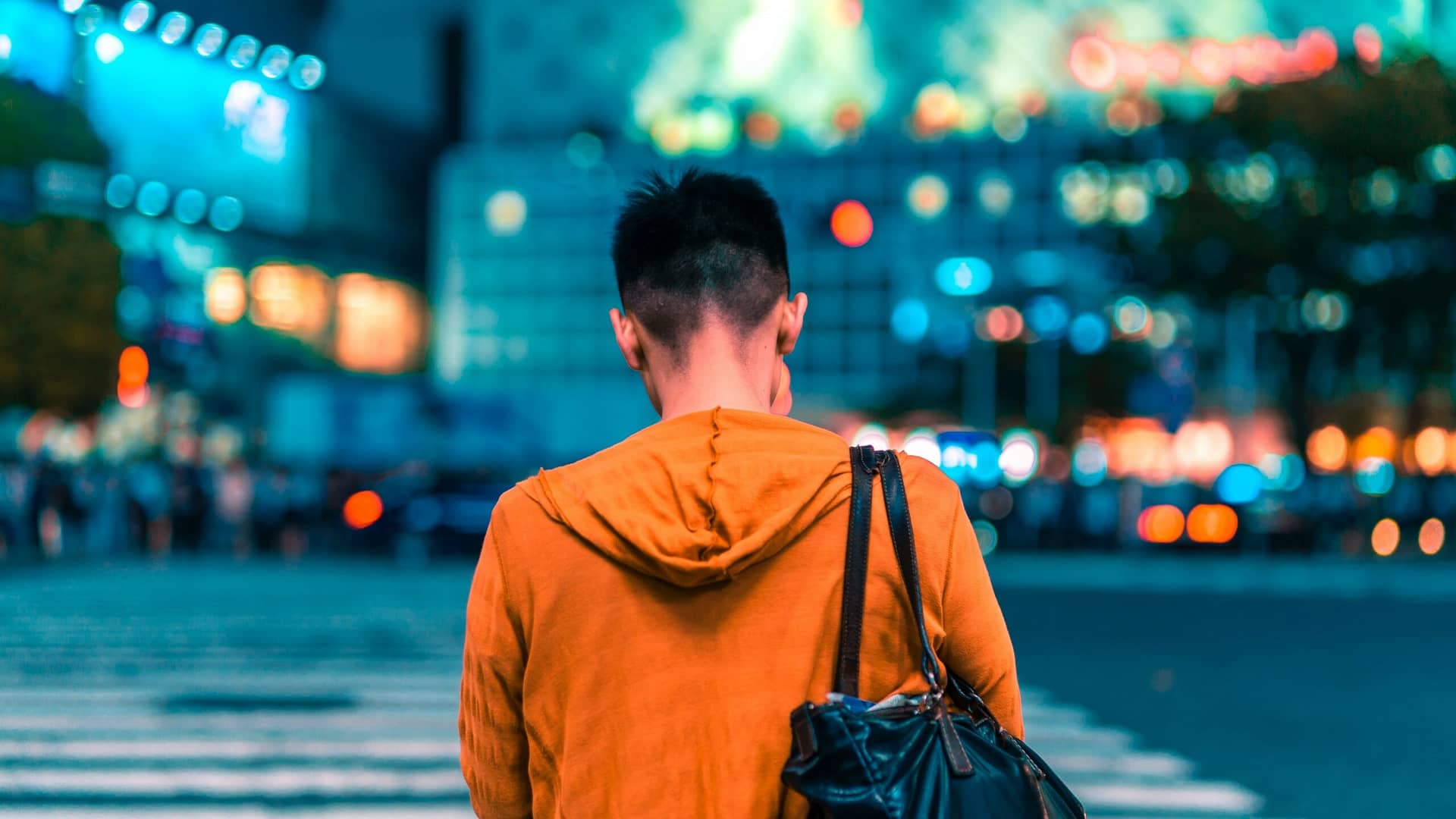What if we could reduce the chances of our relatives, friends, and neighbors being killed or injured by 36, 59, or even 89 percent? 1
What if we could do that while helping our communities to flourish, and improving our health? 2 This fix doesn’t require a miracle, just a shift toward thinking about our streets.
Yes, streets. They are one of our most overlooked community assets. Right now, those streets are designed for cars, but what if we started re-thinking them in terms of people?

The Places We Love, but Better.
What if you were given permission to reimagine the community you love on your terms? How would you like to feel when walking down the street? What would it sound like? What would it smell like? Who would you bump into? No really. Pause here and take a second to think about it.
My guess is that these scenes wouldn’t be enhanced by the sounds of cars speeding by, needing to second guess the safety of stepping onto the crosswalk, or tucking into your meal at your favorite outside seating with the smell of exhaust in the air.
For so long though, these realities have crept into our understanding of how streets “should” be. But streets don’t have to be primarily for cars. In most large cities, 80% of the spaces between buildings is dedicated to cars. People and bikes are often an afterthought to car infrastructure, which leaves those of us on the sidewalk (if there is one) feeling like we’re secondary to the cars rushing by.
So, how might we take a different approach to the way we design our cities, communities, and small towns? There’s a new movement in town: user generated urbanism.
“But wait,” you might say, “Parking is already a nightmare, we can’t invest all that money in changing infrastructure! How will downtown function?!”
Great questions. User generated urbanism responds to this with a simple question: What if we gave ourselves permission to experiment? Nothing would have to be permanent. Lines could be washed away when needed, and seating and barriers temporary. Our communities could figure out what they liked and wanted for themselves with this new idea of what’s possible, and then make things permanent. That would be the power of user generated urbanism; empowering the community and elevating the human experience.
During the COVID-19 pandemic, these kinds of experiments were already popping up all across the United States without us even realizing it! As restaurants and shops were pushed outside and onto the street, we already got a glimpse at what a more connected, less traffic-centric view of the street could look like. And though the result weren’t perfect, it did give us a taste of how we could start to reimagine our cities and communities.
To get us started down this line of imaginative and totally doable rethinking, I want to share with you a great video from Freethink about how and why we’re using our streets wrong and what we can do to make them better!
Special thanks to Freethink for producing this awesome video. If you want to watch more thoughtful videos centered around ideas that can improve our world, go check out and subscribe their YouTube channel.
The Places We Love, But Safer.
If I were asked “Are you a car person or a bike person?”, I’d probably say I’m a car person. I love my car, I do. I love a long drive, I love being able to get into town quickly in a rural area. But my car is a tool, and much in the way I wouldn’t use a sledgehammer to do the work of a screwdriver, it might be time to ask myself why I feel more comfortable driving two blocks in my community instead of walking or biking. Might it be because we’ve created streets that are prioritizing the use of the wrong tool?
Between 2010 and 2019, non-motorist fatalities in the United States increased by 423.6%. According to a 2021 National highway Traffic Safety Administration report, in 2019 there were 6,205 pedestrians, 846 bicyclists, and 287 other non-motorists (e.g. persons riding micromobility devices) killed in crashes with motor vehicles in the United States. In addition, research shows that as many as 44-75% of non-fatal pedestrian crashes and 7-46% of non-fatal bike crashes are missing from police-reported crash data. 4
That’s a lot of deaths and injuries that can be avoided by putting in measures that make people and bikes a priority on our roads and streets.
And this problem isn’t just something to solve in the big cities. As somebody who grew up in a rural area, I thought I was immune to these kinds of statistics, but rural pedestrian and bike crashes make up 18 and 21.8% of fatalities from 2017-2019. This means improving our streets is relevant not only for those of us who may live in cities, but for everyone, everywhere.
If walking and biking are great tools for local travel, how can we make them safer, and empower more people to use them?
Designing streets with sidewalks, improving lighting, and providing bike lanes are just some of the interventions we could take to reduce crash rates by 65-98%, 42%, and 36% respectively and they have a positive ripple effect. 5
By making walking and biking safer and easier, we increase the number of people using these forms of transportation. This has been shown to create a “safety in numbers” effect which even further decreases collision risk. With less drivers on the road and walking and biking becoming more commonplace, risk of accidents decreases. Plus, the increase in walking and biking makes non-car travel more visible, more normalized, and therefore more common! And if we can reduce our environmental impact, make ourselves and our neighbors safer, and create spaces designed for us, why wouldn’t we want to do that?
So How do I take Part?
Ah, great question. Fortunately, there is a lot of excitement out there for making our cities, towns, and communities more bike and walk friendly. The community leaders that are helping to spearhead these initiatives need your voices and support in order to make these changes possible. If you are from a larger city or town try a Google search for “Walk and bike [Your City Name]” or search for a bike shop or statewide organization and reach out to them to see if they know of existing groups in your local area who are improving walking and biking infrastructure. These are great places to get leads to ongoing work that you can support!
As someone from a smaller area, I reached out to a local community leader that I knew could connect me to the people in my town interested in making our community more bikeable and walkable, and I was immediately welcomed into an existing group of community advocates.
Along the way writing this article, I also found some great resources that I would suggest checking out including this site from the Department of Transportation with lots of links to resources and research about the benefits of making more people friendly streets, these interventions that lead to decreased collision rates from the North Carolina Department of Transportation, and a great article from the EPA looking at the impact we could have if we chose alternatives to cars for trips of less than a mile, and how we can make that a possibility.
We can make change if we are open to collaboration, creativity, and sometimes, a little experimentation. Making our streets more walkable and bikeable is such a great place for us to feel the tangible impact we can have on our community. It just starts with a few people questioning the status quo and inviting others to imagine a better, shared future alongside them!
Stay beautiful & keep laughing!
-Liesl

Don’t miss out on a single article!
Enjoy unlimited access to over 500 articles & podcast that give you a positive perspective on the state of the world and show you practical ways you can help.
Notes:
- “Benefits.” Benefits : Walk Bike NC, https://www.ncdot.gov/bikeped/walkbikenc/safety_post/benefits/default.aspx#:~:text=Safety%20in%20Numbers,safer%20for%20pedestrians%20and%20bicyclists. ↩
- “Health.” Pedestrian & Bicycle Information Center, https://www.pedbikeinfo.org/factsfigures/facts_health.cfm. ↩
- freethinkmedia. “We’re Using Our Streets All Wrong | Hard Reset by Freethink.” YouTube, YouTube, 15 Jan. 2022, https://www.youtube.com/watch?v=hK7agOPye6M. ↩
- “Safety.” Pedestrian & Bicycle Information Center, https://www.pedbikeinfo.org/factsfigures/facts_safety.cfm. ↩
- “Benefits.” Benefits : Walk Bike NC, https://www.ncdot.gov/bikeped/walkbikenc/safety_post/benefits/default.aspx#:~:text=Safety%20in%20Numbers,safer%20for%20pedestrians%20and%20bicyclists. ↩








